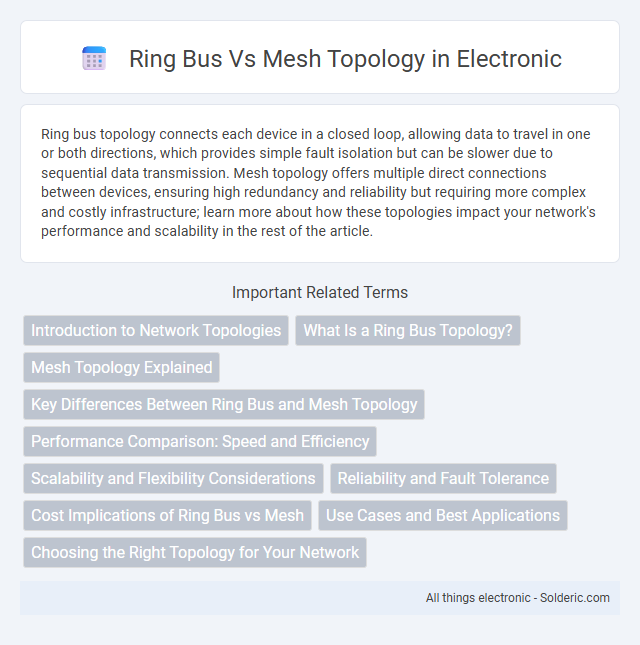Ring bus topology connects each device in a closed loop, allowing data to travel in one or both directions, which provides simple fault isolation but can be slower due to sequential data transmission. Mesh topology offers multiple direct connections between devices, ensuring high redundancy and reliability but requiring more complex and costly infrastructure; learn more about how these topologies impact your network's performance and scalability in the rest of the article.
Comparison Table
| Feature | Ring Topology | Mesh Topology |
|---|---|---|
| Structure | Devices connected in a closed loop | Devices interconnected with multiple redundant links |
| Data Flow | Unidirectional or bidirectional data transmission | Direct data transmission between nodes |
| Scalability | Limited, adding devices can disrupt network | Highly scalable, easy to add nodes without disruption |
| Fault Tolerance | Single point of failure possible; requires bypass mechanism | High fault tolerance; multiple alternative paths |
| Cost | Lower cost; fewer cables and ports | Higher cost; extensive cabling and ports needed |
| Performance | Dependent on token passing; can be slower under high load | High performance; simultaneous data transmission possible |
| Use Cases | Ring-based networks like SONET, FDDI | Critical systems requiring high availability and redundancy |
Introduction to Network Topologies
Ring bus topology features nodes connected in a closed loop, where data travels in one or both directions, optimizing fault isolation and reducing cable usage. Mesh topology creates a network with multiple paths between nodes, enhancing redundancy and fault tolerance but increasing complexity and cost. Both topologies are crucial in network design, with ring bus suited for cost-effective, simpler networks and mesh ideal for high-reliability environments demanding robust connectivity.
What Is a Ring Bus Topology?
A Ring Bus Topology is a network configuration where each device is connected to exactly two other devices, forming a circular data path that allows for unidirectional or bidirectional data transmission. It combines the characteristics of ring and bus topologies, enhancing fault tolerance by enabling data to travel in multiple directions, which minimizes network downtime. Understanding your network's requirements helps determine if a Ring Bus Topology suits your need for reliable and efficient data flow.
Mesh Topology Explained
Mesh topology consists of multiple interconnected devices, ensuring every node directly links to several others for optimal data transmission and fault tolerance. Your network benefits from enhanced reliability and reduced downtime since data can travel through various paths if one connection fails. This structure supports high levels of redundancy and is ideal for environments where consistent network performance is critical.
Key Differences Between Ring Bus and Mesh Topology
Ring topology connects nodes in a closed loop where each device is linked to two other devices, enabling data to travel in a single direction or both ways. Mesh topology involves every node having a direct connection to every other node, ensuring high redundancy and fault tolerance through multiple communication paths. The key differences include the complexity and cost of implementation, with ring topology being simpler and less expensive, while mesh offers superior reliability and performance due to its multiple direct links between nodes.
Performance Comparison: Speed and Efficiency
Ring bus topology offers consistent data transmission speed by circulating data in a unidirectional or bidirectional loop, which reduces collision chances but may suffer delays as network size increases. Mesh topology provides superior speed and efficiency due to direct point-to-point connections between devices, enabling multiple simultaneous data transmissions and higher fault tolerance. Your network performance will benefit from mesh topology in high-demand environments requiring rapid data exchange and minimal downtime.
Scalability and Flexibility Considerations
Mesh topology offers superior scalability by allowing easy addition of new nodes without disrupting the existing network, supporting large-scale and dynamic environments efficiently. Ring bus topology faces limitations in scalability since adding nodes requires breaking the ring temporarily, which can cause downtime and complicate network management. Flexibility is higher in mesh networks due to multiple redundant paths for data transmission, enhancing fault tolerance and load balancing compared to the more rigid ring bus structure.
Reliability and Fault Tolerance
Ring bus topology offers moderate fault tolerance since a break in the ring can disrupt the entire network unless dual rings or bypass mechanisms are implemented. Mesh topology provides superior reliability and fault tolerance by creating multiple redundant paths between nodes, ensuring continuous network operation even if several links fail. You can enhance your network's resilience significantly by choosing mesh topology for critical applications requiring high availability.
Cost Implications of Ring Bus vs Mesh
Ring bus topology generally incurs lower costs due to fewer cabling requirements and simpler network devices compared to mesh topology, which demands extensive cabling and multiple connections. Mesh topology, while more expensive, offers superior redundancy and fault tolerance by providing multiple data paths, reducing potential downtime. Your choice between ring bus and mesh should balance budget constraints against the need for reliability and network resilience.
Use Cases and Best Applications
Ring bus topology excels in environments requiring predictable data transmission times, such as fiber optic networks and metropolitan area networks (MANs), due to its orderly data flow and minimal collision chances. Mesh topology is ideal for mission-critical applications like data centers, military communication, and IoT networks, thanks to its robust redundancy, fault tolerance, and high availability. Choosing between the two depends on factors like network size, scalability needs, and fault tolerance requirements, with ring bus suited for moderate-sized networks and mesh optimal for complex, large-scale infrastructures.
Choosing the Right Topology for Your Network
Choosing the right topology for your network depends on factors like scalability, fault tolerance, and data traffic patterns. Ring topology offers predictable data flow and easier fault isolation but can suffer from downtime if a single node fails. Mesh topology provides higher redundancy and resilience by connecting every device directly, ensuring Your network remains operational even during multiple link failures.
Ring bus vs Mesh topology Infographic

 solderic.com
solderic.com